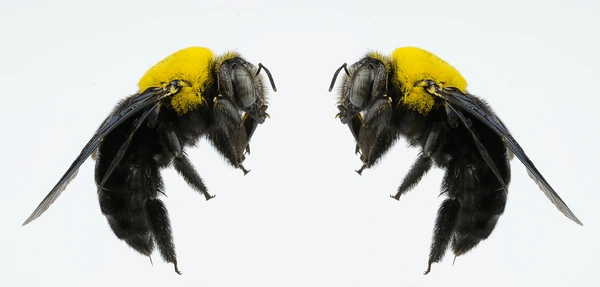Carpenter bees are fascinating creatures that often evoke curiosity and concern. While their role in nature is significant, their presence around your home can sometimes become a nuisance. In this guide, we’ll explore everything about carpenter bees, including whether they sting, their nesting habits, and how to get rid of them if necessary.
What are Carpenter Bees?
Carpenter bees, belonging to the genus Xylocopa, are among the largest native bees in the United States, sharing the title with bumble bee queens. These gentle giants are known for their fascinating nesting habits and their crucial role in pollination. Unlike bumblebees, carpenter bees have a shiny black abdomen and are less hairy. These industrious insects play an essential role in pollination, making them beneficial to the environment.
Carpenter bees primarily feed on nectar from flowers, which provides them with the energy needed for their activities. They are also excellent pollinators, as they inadvertently transfer pollen between plants while foraging for nectar. This behavior plays a vital role in the reproduction of many plant species.
Carpenter Bee Family
Carpenter bees belong to the family Apidae, which includes other well-known bees like honey bees and bumble bees. The genus Xylocopa comprises numerous species, each adapted to thrive in a variety of ecosystems ranging from tropical to subtropical to temperate regions. These bees are solitary in nature, unlike honey bees and bumble bees that form colonies.
Also Read:- Bumble Bee Vs Carpenter Bee
Where are Carpenter Bees Found?
Carpenter bees are widely distributed across the globe, with species inhabiting diverse climates. In the United States, they are commonly found in:
- The southern regions, from Arizona to Florida.
- The eastern states, reaching as far north as New York.
Carpenter bees are versatile and can adapt to various environments, including forests, grasslands, and even urban areas. While they prefer dead but non-decayed wood for nesting, some species, such as the eastern Xylocopa virginica, can occasionally create nests in fence posts, redwood structures, or other wooden timbers.
Do Carpenter Bees Sting?
One of the most common concerns about carpenter bees is whether they sting. Female carpenter bees have stingers and can sting if provoked. However, they are not aggressive and rarely sting unless threatened. Male carpenter bees, on the other hand, cannot sting at all but may exhibit territorial behavior by buzzing close to people.
Are Carpenter Bees Pollinators?

Yes, carpenter bees are excellent pollinators. They contribute to the ecosystem by pollinating a variety of plants and flowers. Their ability to perform “buzz pollination” makes them valuable, especially for plants like tomatoes, blueberries, and eggplants.
How Do You Get Rid of Carpenter Bees?
Getting rid of carpenter bees requires a balanced approach since they are important pollinators. Here are some effective methods:
1. Carpenter Bee Traps
These traps lure the bees into a container from which they cannot escape.
2. Sealing Holes
Use wood filler or caulk to seal existing holes after ensuring the bees have vacated.
3. Applying Insecticides
Targeted application of insecticides can help manage an infestation.
4. Using Natural Detergents
Citrus oil sprays and almond oil are known to repel carpenter bees naturally.
5. Preventive Measures
Painting or staining exposed wood can discourage bees from nesting.
Carpenter bees are both a friend and a foe. While they are remarkable pollinators that benefit the environment, their nesting habits can lead to structural damage. By using preventive measures and humane solutions like carpenter bee traps, you can strike a balance between protecting your home and supporting these vital insects.
Understanding their habits and ecological importance ensures that we coexist peacefully with carpenter bees. After all, their buzzing presence is a reminder of nature’s intricate balance.





